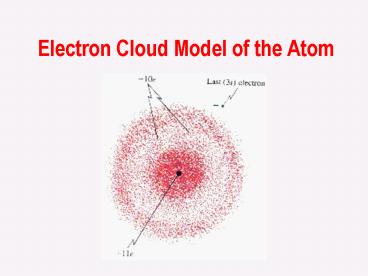Electron Cloud Model of the Atom - PowerPoint PPT Presentation
1 / 20
Title:
Electron Cloud Model of the Atom
Description:
p orbitals have a figure 8 type shape: there are 3 kinds of p orbitals ... f orbital shapes become more complex. There are 7 kinds of f orbitals. Magnetic ... – PowerPoint PPT presentation
Number of Views:181
Avg rating:3.0/5.0
Title: Electron Cloud Model of the Atom
1
Electron Cloud Model of the Atom
2
What is an orbital????
- An orbital is a 3 dimensional area in space where
an electron may be found. It does not have a set
pattern to it like in the Bohr Model of the atom! - It is a cloud like area around the nucleus where
the electron can be found 95 of the time. Much
like light, electrons have properties of both a
particle and a wave and do not travel in a path
like planets around a star!!!!
3
The Heisenberg Uncertainty Principle
- This states that it is impossible to know both
the position and velocity of an electron at the
same time. - So in an orbital (electron cloud) it is not
possible to know exactly where an electron is at
any one moment. The orbital represents an area
in space , the probability of finding electrons
in that region.
4
- This model is also sometimes called the quantum
mechanical model of the atom
5
Quantum numbers
- There are 4 different quantum numbers.
- These quantum numbers describe the location of an
electron around the nucleus of the atom - No 2 electrons can have the same 4 quantum
numbers in an atom. If they did it would
indicate that they are occupying the same area in
space around the nucleus
6
Principal Quantum Number
- Generally symbolized by n, it denotes the energy
level in which the electron is located. - These are whole numbers, 1,2,3,.
7
Angular Momentum Quantum Number
- The angular momentum quantum number, denotes the
orbital in which the electron is located. This
indicates the shape of the orbital
8
The four types of orbitals
- The 4 types of orbitals are called
- s, p, d and f
- s orbitals are spherical in shape
9
p orbitals have a figure 8 type shape there
are 3 kinds of p orbitals
10
d orbitals are mostly like a 4 leaf clover type
shape. There are 5 kinds of d orbitals
11
f orbital shapes become more complex. There are
7 kinds of f orbitals
12
Magnetic Quantum Number
- The magnetic quantum number shows the orientation
of the electrons orbital with respect to the
three axes in space.
13
Spin Quantum Number
- Spin quantum number denotes the behavior
(direction of spin) of an electron within a
magnetic field. - Possibilities for electron spin
- 1/2 or 1/2
14
4.3 Electron Configuration
- 3 rules for adding electrons to orbitals
- Aufbau principle an electron occupies the
lowest-energy orbital that can receive it - Pauli exclusion principle no two electrons in
the same atom can have the same set of four
quantum numbers - Hunds rule orbitals of equal energy are each
occupied by one electron before any orbital is
occupied by a second electron, and all electrons
in singly occupied orbital must have the same
spin
15
Representing electron configuration
- The electron configuration for boron is 1s22s22p1
- How many electrons are present in an atom of
boron? - What is the atomic number?
- Write the orbital notation for boron
- ?? ?? ? ___ ___
- 1s 2s 2px 2py 2pz
16
Practice write the electron configuration for
nitrogen
- ?? ?? ? ? ?
- 1s 2s 2px 2py 2pz
17
Maximum number of electrons in each sublevel
- s orbital 2 electrons
- p orbital 6 electrons
- d orbital 10 electrons
- f orbital 14 electrons
18
Orbital filling table
19
- Electron configuration of the elements of the
first three series
20
Irregular confirmations of Cr and Cu
Chromium steals a 4s electron to half fill its
3d sublevel
Copper steals a 4s electron to FILL its 3d
sublevel































